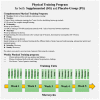Supply of Antioxidants vs. Recruit Firefighters' Cellular Immune Status: A Randomized Double-Blinded Placebo-Controlled Parallel-Group Trial
- PMID: 35743844
- PMCID: PMC9225374
- DOI: 10.3390/life12060813
Supply of Antioxidants vs. Recruit Firefighters' Cellular Immune Status: A Randomized Double-Blinded Placebo-Controlled Parallel-Group Trial
Abstract
Background: Physical exercise can affect the immune system. We studied the effect of antioxidants on hematological and immune biomarkers after heavy training. Methods: 24 well-trained and well-fed male firefighters were randomly divided into supplemented and placebo groups, and tested for immunology-related variables using venous blood samples in the fasting state, pre- (M1) and post- (M2) five weeks of daily micronutrient supplementation (15 mg of beta-carotene, 200 mg of vitamin C, 136 mg of vitamin E, 200 μg of selenium, 15 mg of zinc, 100 mg of magnesium). Total leukocytes and a differential count for five populations were determined using standard procedures (MAXM—Beckman Coulter Diagnostics; Brea, CA, USA). Lymphocyte subsets were determined through immunophenotyping. Results: Although all values were within the normal range for healthy adults and athletes in the supplemented group (SG), mean CD3+CD8+, CD8+ and CD16+CD56+ decreased (p < 0.05; small to moderate effects), while mean CD4+, CD19+ and CD4+/CD8+ increased (p < 0.05; small effects) after five-weeks. Regarding the placebo group (PG), higher total leukocyte count (p < 0.05; trivial effect) and natural killer cells percentage (CD16+CD56+; p < 0.05; moderate effect) were observed when comparing M1 and M2. Conclusions: Antioxidants supplementation did not alter well-fed male firefighters recruit firefighters’ immune cell response during the five-week physical training program.
Keywords: antioxidants; exercise; exercise physiology; firefighters; health; leukocytes; lymphocyte subsets; lymphocytes; micronutrients; nutrition; recruits; supplementation; training and testing.
Conflict of interest statement
The authors declare no potential conflict of interest concerning the research, authorship, and/or publication of this article.
Figures
Similar articles
-
Reference ranges of lymphocyte subsets in healthy adults and adolescents with special mention of T cell maturation subsets in adults of South Florida.Immunobiology. 2014 Jul;219(7):487-96. doi: 10.1016/j.imbio.2014.02.010. Epub 2014 Mar 2. Immunobiology. 2014. PMID: 24661720
-
Multi-Micronutrient Supplementation and Immunoglobulin Response in Well-Fed Firefighters.Sports Med Int Open. 2020 Dec 17;5(1):E1-E7. doi: 10.1055/a-1296-1486. eCollection 2021 Jan. Sports Med Int Open. 2020. PMID: 33376770 Free PMC article.
-
The effects of altered exercise distribution on lymphocyte subpopulations.Eur J Appl Physiol Occup Physiol. 1995;72(1-2):157-64. doi: 10.1007/BF00964131. Eur J Appl Physiol Occup Physiol. 1995. PMID: 8789587 Clinical Trial.
-
Effect of blood transfusion during radiotherapy on the immune function of patients with cancer of the uterine cervix: role of interleukin-10.Int J Radiat Oncol Biol Phys. 2002 Dec 1;54(5):1345-55. doi: 10.1016/s0360-3016(02)03757-4. Int J Radiat Oncol Biol Phys. 2002. PMID: 12459356
-
[Deep lung--cellular reaction to HIV].Rev Port Pneumol. 2007 Mar-Apr;13(2):175-212. Rev Port Pneumol. 2007. PMID: 17492233 Review. Portuguese.
Cited by
-
Vitamin D, selenium, and antidiabetic drugs in the treatment of type 2 diabetes mellitus with Hashimoto's thyroiditis.World J Diabetes. 2024 Feb 15;15(2):209-219. doi: 10.4239/wjd.v15.i2.209. World J Diabetes. 2024. PMID: 38464371 Free PMC article.
References
-
- Jakubczyk K., Dec K., Kałduńska J., Kawczuga D., Kochman J., Janda K. Reactive oxygen species—Sources, functions, oxidative damage. Pol. Merkur. Lekarski. 2020;48:124–127. - PubMed
Grants and funding
LinkOut - more resources
Full Text Sources
Research Materials



